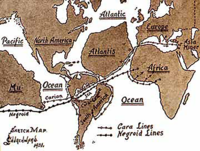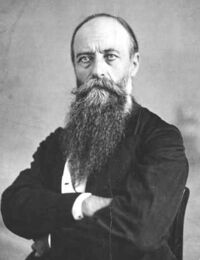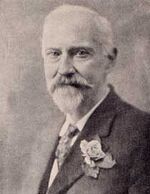Lost Civilization of Mu: Difference between revisions
No edit summary |
|||
| Line 6: | Line 6: | ||
[[File:Mu.png|200px|thumb|Map of Mu]] | [[File:Mu.png|200px|thumb|Map of Mu]] | ||
The lost continent of Mu is one of many so called “lost civilizations” located in the Atlantic Ocean. This civilization has many similarities to other more famous locations such as Atlantis and Lemuria. It has even been said that these civilizations are one in the same. The civilization is said to have links to various other cultures as well including the Mayan, Egyptian, Greek and many other cultures all around the world. Mu itself has had multiple locations of interest for its location including the Atlantic Ocean and the Pacific Ocean as well. A well known remnant of their civilization is supposedly Easter Island and the sculptures located there. The existence of the civilization has never been proved through scientific means, however through translated writings of both Mayan and Egyptian by a couple of archaeologists providing most of the information known about this civilization. | ===Lost Continents=== | ||
Lost Continents throughout history have been a topic of much interest for many as the discovery of these places proposes much fame to whoever finally finds them. The idea of these continents stem from maps and writings detailing the existence of places that are unable to be found in our current landscape In the scientific community however the existence of the lands has never been proven and proof of these civilizations existing is few and far between. Possibly the most famous lost continent is known as Atlantis which has appeared in many forms of popular media from books to movies to video games. The idea of lost continents has been ingrained into the human psyche through these forms of media and with these in mind the passion to find these mythical places has survived despite lack of scientific proof. | |||
===Overview of Mu=== | |||
The lost continent of Mu is one of these many so called “lost civilizations” located in the Atlantic Ocean. This civilization has many similarities to other more famous locations such as Atlantis and Lemuria. It has even been said that these civilizations are one in the same. The civilization is said to have links to various other cultures as well including the Mayan, Egyptian, Greek and many other cultures all around the world. Mu itself has had multiple locations of interest for its location including the Atlantic Ocean and the Pacific Ocean as well. A well known remnant of their civilization is supposedly Easter Island and the sculptures located there. The existence of the civilization has never been proved through scientific means, however through translated writings of both Mayan and Egyptian by a couple of archaeologists providing most of the information known about this civilization. The information provided is very different depending on who was head of the research at the time. The legends about the continent spread far from its influence on our current culture to the ancient cultures of the past. Mu was said to be a highly populated continent before its downfall although no traces of their culture or direct descent from this legendary place have been found. | |||
==Augustus de Plongeon== | ==Augustus de Plongeon== | ||
| Line 21: | Line 26: | ||
After Plongeon’s time another man named James Churchward picked up the mantle of research on Mu. Churchward, although of similar ideologies to Plongeon, was not an archaeologist; rather he was an engineer without much archaeological background. His research was found similarly to Plongeon, through ancient scripts in an ancient language with little to no native speakers. Through these scripts Churchward proclaimed that the ancient civilization was located in the Pacific Ocean which opposed the previous findings by Plongeon that they were located in the Atlantic Ocean. Churchward inevitably faced much backlash from the scientific community as his claims had absolutely no scientific proof and the scripts, tablets, and texts he supposedly translated were not able to be confirmed due to the lack of people able to read the ancient language. Churchward still continued to expand the mythos of Mu despite the lack of support and has since become the face of Mu research. | After Plongeon’s time another man named James Churchward picked up the mantle of research on Mu. Churchward, although of similar ideologies to Plongeon, was not an archaeologist; rather he was an engineer without much archaeological background. His research was found similarly to Plongeon, through ancient scripts in an ancient language with little to no native speakers. Through these scripts Churchward proclaimed that the ancient civilization was located in the Pacific Ocean which opposed the previous findings by Plongeon that they were located in the Atlantic Ocean. Churchward inevitably faced much backlash from the scientific community as his claims had absolutely no scientific proof and the scripts, tablets, and texts he supposedly translated were not able to be confirmed due to the lack of people able to read the ancient language. Churchward still continued to expand the mythos of Mu despite the lack of support and has since become the face of Mu research. | ||
==Post Plongeon and Churchward== | |||
==Psuedoarcheological Narrative== | ==Psuedoarcheological Narrative== | ||
Revision as of 23:01, 3 December 2021
The Lost Civilization of Mu
Lost Civilization of Mu

Lost Continents
Lost Continents throughout history have been a topic of much interest for many as the discovery of these places proposes much fame to whoever finally finds them. The idea of these continents stem from maps and writings detailing the existence of places that are unable to be found in our current landscape In the scientific community however the existence of the lands has never been proven and proof of these civilizations existing is few and far between. Possibly the most famous lost continent is known as Atlantis which has appeared in many forms of popular media from books to movies to video games. The idea of lost continents has been ingrained into the human psyche through these forms of media and with these in mind the passion to find these mythical places has survived despite lack of scientific proof.
Overview of Mu
The lost continent of Mu is one of these many so called “lost civilizations” located in the Atlantic Ocean. This civilization has many similarities to other more famous locations such as Atlantis and Lemuria. It has even been said that these civilizations are one in the same. The civilization is said to have links to various other cultures as well including the Mayan, Egyptian, Greek and many other cultures all around the world. Mu itself has had multiple locations of interest for its location including the Atlantic Ocean and the Pacific Ocean as well. A well known remnant of their civilization is supposedly Easter Island and the sculptures located there. The existence of the civilization has never been proved through scientific means, however through translated writings of both Mayan and Egyptian by a couple of archaeologists providing most of the information known about this civilization. The information provided is very different depending on who was head of the research at the time. The legends about the continent spread far from its influence on our current culture to the ancient cultures of the past. Mu was said to be a highly populated continent before its downfall although no traces of their culture or direct descent from this legendary place have been found.
Augustus de Plongeon

Life
The narrative of the lost civilization of Mu originates from the work to decipher ancient mayan writings by a proclaimed archaeologist Augustus de Plongeon. De Plongeon was born in Jersey on May 4, 1826 and began traveling at the young age of 19. After his initial explorations he began to learn photography which he later used when he explored sites to help document artifacts and structures. However, as an archaeologist he had many differing opinions compared to that of his peers. He believed that the origin of civilizations had roots in the New World rather than the Old World. This led into his theories about Mu and how it had influenced many societies throughout the world. De Plongeon first “discovered” Mu through translations of the Mayans writings using previous translations by Charles Étienne Brasseur de Bourbourg. These translations however were flawed but included a reference to the lost civilization of Mu. This reference spiked Plongeon’s interest and so he began work on researching this civilization. Plongeon’s beliefs on the society include the hyper diffusion of their culture to other civilizations before their inevitable downfall as a “lost civilization”. Part of his ideology on the ordeal was that the ancient Mu people brought their culture around the world to explain the similarities in the cultural architecture of the ancient Mayan and Egyptian people. This includes the fleeing of the people to both Central America for the Mayans and their supposed Queen Moo who fled to Egypt to start their culture. Plongeon’s bold claims of hyperdiffusion led his other peers to scrutinize his ideas of Mu and the mistakes in both his lack of proof and ideology.
Delusions of Grandeur
James Churchward

After Plongeon’s time another man named James Churchward picked up the mantle of research on Mu. Churchward, although of similar ideologies to Plongeon, was not an archaeologist; rather he was an engineer without much archaeological background. His research was found similarly to Plongeon, through ancient scripts in an ancient language with little to no native speakers. Through these scripts Churchward proclaimed that the ancient civilization was located in the Pacific Ocean which opposed the previous findings by Plongeon that they were located in the Atlantic Ocean. Churchward inevitably faced much backlash from the scientific community as his claims had absolutely no scientific proof and the scripts, tablets, and texts he supposedly translated were not able to be confirmed due to the lack of people able to read the ancient language. Churchward still continued to expand the mythos of Mu despite the lack of support and has since become the face of Mu research.
Post Plongeon and Churchward
Psuedoarcheological Narrative
Existence of Lost Continents
The existence of “lost continents” such as Mu have never been proved through actual scientific means, in fact just the existence of the actual continents themselves have been proven to be highly unlikely. With an increase in human technological abilities throughout time new methods of data gathering have shown that there is very little geological evidence for a whole continent to just disappear into the ocean. The research put into plate tectonics has actually revealed the existence of some lost continents. Researchers were able to find remnants of a continent that was destroyed by movements of tectonic plates near the Adriatic Sea. This continent known as Greater Adria existed millions of years ago before its destruction, much before the time of humanity. This process of the disappearance of this continent as well as the movement of the earth’s crust takes an unprecedented amount of time to occur. Continents do not just disappear in a matter of a few thousand years, it takes hundreds of thousands even millions before this takes place. The sudden disappearance of Mu in the context of even multiple generations of their civilization is nearly impossible barring a possible natural disaster on a scale large enough to destroy not only the continent itself, but also the destruction of the artifacts of its people. Despite this possibility the lack of any remnants at all provides a large problem for any argument for the existence of Mu. Unless the whole continent was destroyed including the crust itself linking the continent to the rest of the Earth the location of the continent could be found and the area could be researched further. However, the lack of existence of any remnants regarding the actual structure of the continent gives no scientific reasoning for it to have ever existed. This is further emphasized through the lack of any other real proof provided by the so-called “researchers’ of Mu.
Artifacts and the Lack of Them
The real problem with the existence of Mu stems from the lack of any archaeological proof of the existence of this civilization. While Plongeon and Churchward tried their best to provide the full story of Mu and the history of its civilization they failed in their attempts to provide any real proof of the civilization. Both of them were only ever able to provide translations of ancient text as their whole argument. While the “translations” they examined did seem to detail the civilization of Mu, that is simply all there is to back up their claims. These translations have never been proved in the context of science. Plongeon examined old Mayan ruins to translate their work, however the translations he used were not even correct. He based his whole argument for Mu’s existence on the flawed and incomplete translations of another man named Charles Étienne Brasseur de Bourbourg. Bourboug had previously attempted to translate the Mayan language and failed in his attempts before Plongeon’s use of them. While Plongeon’s translations were outlandish and flawed in many ways, Churchward’s use of translations was possibly even more atrocious. The language on the scripts came from an old Indian priest, in a language supposedly only known to few people. Along with Churchward’s self ideal of believing he had the innate ability to understand the meaning of these scripts the credibility of his claims simply put is non-existent. Neither Plongeon or Churchward could even assemble a smidge of credibility for their outlandish claims other than what they had “read” and “learned” from others. In order to build a credible argument more proof is necessary: scientific proof, artifacts from the culture, remnants of the society, etc. The lack of any of these lead other scientists at the time to discredit their work entirely. While the motivations behind the pseudo-archaeology of Plongeon and Churchward was never explicitly stated the two of them both fully believed in what they were doing. Pseudo Archaeologists typically are after the fame and legacy of the find without the hard work put into the science of a find. Their lack of effort to provide any real proof despite their grand ideas is a sign of their lack of ability as researchers and as well their lack of any credibility at all.
Bibliography
Sources
"Le Plongeon, Augustus (1826–1908) ." Encyclopedia of Latin American History and Culture. . Encyclopedia.com. 25 Nov. 2021 <https://www.encyclopedia.com>.
Prof. Geller, et al. “Mu - Ancient Lost Continent.” Mythology.net, 1 Nov. 2016, https://mythology.net/others/concepts/mu/.
"Churchward, James (1852-1936) ." Encyclopedia of Occultism and Parapsychology. . Encyclopedia.com. 25 Nov. 2021 <https://www.encyclopedia.com>.
“Seafloor Spreading.” Edited by Jeannie Evers, National Geographic Society, National Geographic, 9 Oct. 2012, https://www.nationalgeographic.org/encyclopedia/seafloor-spreading/.
Njoku, Chisom. “Discover the Lost Civilization of Mu.” The Guardian Nigeria News - Nigeria and World News, Life, 30 May 2019, https://guardian.ng/life/culture-lifestyle/discover-the-lost-civilization-of-mu/.
Churchward, James, and David Hatcher Childress. The Lost Continent of Mu. Adventures Unlimited Press, 2007.
“Maya.” Edited by History.com Editors, History.com, A&E Television Networks, 29 Oct. 2009, https://www.history.com/topics/ancient-americas/maya.
Andrews, Robin George. “Lost Continent Revealed in New Reconstruction of Geologic History.” Science, National Geographic, 3 May 2021, https://www.nationalgeographic.com/science/article/lost-continent-revealed-by-plate-tectonics-model-greater-adria-mediterranean.
Images
“Category:1931 Maps.” Wikimedia Commons, https://commons.wikimedia.org/wiki/Category:1931_maps.
“Commons:Upload.” Wikimedia Commons, https://commons.wikimedia.org/wiki/Commons:Upload.
“Archivo:Augustus-Le-Plongeon-Photo.jpeg - Wikipedia Republished // Wiki 2.” - Wikipedia Republished // WIKI 2, https://wiki2.org/es/Archivo:Augustus-le-plongeon-photo_jpeg.